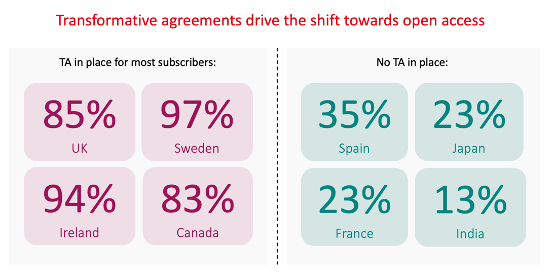Ten years of Transformative Agreements

Julian Wilson
Julian Wilson asks: are TAs delivering on their promise for open access?
It took a bit of faith, when the Austrian Science Fund (FWF) and the Austrian Academic Consortium (KEMO) signed their first off-setting open access (OA) publishing contract with us 10 years ago.
The contract would become one of the very first to consolidate the costs of both reading and publishing OA into a single national agreement and would become our starting point for arranging some of the first transformative agreements (TAs).
First transformative agreements
Those first agreements were a direct response to funders changing their mandates to stimulate greater openness and accessibility in the dissemination of research. Since their inception, the scale and scope of these TAs have expanded. Initially, these agreements would typically offer open access publishing for a limited number of articles and would only cover certain institutions. More and more TAs now offer unlimited open access publishing on a bigger scale involving national consortia that cover entire countries or regions.
Easier for authors and librarians
For authors, TAs have made it easier to publish their work OA as the cost of doing so is covered by their institutions. They have also simplified budget management for librarians as all the APCs are brought into one single contract rather than funded through various sources that are 'in the wild'.
But how effective are these contracts and are they delivering on their promise to enable the transition to full and immediate open access to research?

When we look at our figures, we see that globally the number of articles published under a TA in 2023 grew much faster compared to articles published OA outside of our TAs. This demonstrates the effectiveness of these agreements to encourage greater uptake of OA publishing. At the end of 2023, 31% of our total OA journal output was published under such an agreement and we see this growing uptake of TAs across the industry.
On a country level, we see that countries where we have a TA with a national consortium have much higher levels of OA output compared to countries where we either don't have TAs, or our TA coverage is limited to individual institutions. In the graph below you see that the UK, Sweden, Ireland and Canada are able to publish between 83% and 97% of their articles OA under one of our TAs. Whereas Spain, Japan, France and India, where we only have TAs with individual institutions, the output of open research articles is significantly lower.
However, when we look at the effectiveness of TAs at individual institutions, we see some impressive results. For instance, before the Canadian Research Consortium (CRKN) secured their TA with us, only 28% of their research was published OA. That percentage increased to 87% in the first year of the agreement, reaching 96% in its second year.
No one size fits all
Tailoring our TAs in a sustainable and equitable way is important to us as we want to ensure they are as inclusive and affordable as possible. We actively work with customers and consortia in the Global South and have been successful in striking TAs with customers in India, Colombia and Mexico. A great example of this is our agreement with the National Autonomous University of Mexico (UNAM). In 2022, before their agreement began, authors from UNAM published only a handful of papers open access. By the end of 2023, with a TA in place, UNAM's open access publishing has grown by more than 250%!
Addressing funding inequalities
Of course, there is still a lot more work to be done. As the OA publishing model typically shifts the cost from readers to authors or their institutions through article publication charges (APCs), there is a growing need to support those with limited access to funding.
The disparities in accessible and available funding are a cause for serious concern if we are to create an equitable OA landscape. Funding inequalities are particularly pronounced when comparing institutions in lower-middle income countries to regions with high levels of research funding such as Europe, the United States and China. This imbalance in funding poses a significant hurdle for researchers at institutions from less economically developed regions, limiting their capacity to publish their work openly. Addressing these disparities is crucial if we are to create an equitable open access publishing landscape.
Discounts and waivers for all journals
Many publishers offer APC discounts and waivers to support researchers from low- and middle-income countries. However, such waivers and discounts are generally only available at a limited number of fully OA journals. At IOP Publishing we offer APC waivers and discounts across all IOP journals – fully OA and hybrid – because we firmly believe that our authors should be able to benefit from publishing OA in the journal of their choice.
Even though there are more and better open-access journals now, most research still gets published in hybrid journals. For example, in physics, only about one-third of articles are published in fully open-access journals each year. If discounts on publishing fees are only applied to open-access journals, it limits options for researchers who rely on financial support. To make OA fairer, researchers should have the chance to publish their work in the journal that suits them best. Giving discounts to more types of journals is part of making this happen.
We know discounts and waivers alone will not solve the equality gap, but as the OA landscape takes shape, they do offer a means to give more researchers the opportunity to take part in global scientific progress in an open world.
Overall, TAs are instrumental in reshaping the scholarly publishing landscape, gradually transitioning from a subscription-based model to one that prioritises OA, thereby democratising access to research outputs.
Julian Wilson is Chief Sales Officer at IOP Publishing






